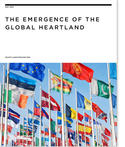After two painful recessions and ever greater national discord, there is considerable support for a new beginning, even if it takes massive federal spending. The question we must ask now is what kind of spending makes sense given the character of the country, its geography, and its economic challenges. America remains a vast and diverse place, and decisions that make sense for one locale do not necessarily make any sense in others. A dispersed country needs dispersed decision-making, not edicts issued from on high by the D.C. nomenklatura. read more »
Demographics
Cricket Leagues in the Global Heartland
The cracking sound of cricket bats is echoing amid the gently rolling hills and plains of Iowa.
With leagues springing up like soybeans, cricket is drawing players and fans in the Heartland, spurred by demographic change and a growing economy. Cricket’s growth in the Heartland reflects immigrants transplanting to American soil a homeland sports tradition – and enriching the culture we share. read more »
- Login to post comments
Why Jews Are Confused
Assailed from two sides, American Jewry is having an acute crisis of identity.
Es iz schver tzu zein a yid. (It is hard to be a Jew.)
—Sholem Aleichem read more »
- Login to post comments
Census Bureau Releases 2020 City Population Estimates
The US Census Bureau has just released its July 1, 2020 population estimates for the approximately 19,500 incorporated municipalities (principally called cities, towns, villages). This article provides information on the 50 largest municipalities in the nation (Table below). read more »
The Emergence of the Global Heartland
A major shift in the demographic evolution of America is occurring, largely out of sight in the national media, but profoundly affecting communities throughout the Heartland.
The 20 state region, which extends between the Appalachians and the Rockies, has for generations been largely unaffected by the massive movement of people from abroad that has so dramatically transformed the great metropolitan regions of coastal America. read more »
- Login to post comments
Combined Statistical Areas Lead Continuing Dispersion: 2010-2020
A commenter asked about population trends in combined statistical areas (CSA) in response to my article “Demographic Implosion in the San Francisco Bay Area?, posted on May 18. This article deals with CSA population trends in the 88 CSAs with more than 500,000 population. read more »
- Login to post comments
Demographic Implosion in the San Francisco Bay Area?
As the San Francisco Bay Area (combined statistical area, or CSA, as defined by the Office of Management and Budget) has sprawled into the San Joaquin Valley, all population growth has been in the three Valley metros for two years (Map above). This article describes population trends over the last 10 years in the CSA, which includes the six tidewater (adjacent to the ocean or the Bay) metropolitan areas, traditionally thought of as the Bay Area, including core San Francisco and San Jose as well as Santa Rosa, Napa, Vallejo and Santa Cruz. read more »
The Rust Belt Aesthetic
Overseas competition. Automation replacing industrial labor. The inability to adapt to the global economy. Unions. Even the weather. Many reasons are given for why Rust Belt cities have lagged the rest of the nation in their recovery from their industrial heyday. But there’s one under-recognized but still consequential reason – the poor quality of the Rust Belt aesthetic. Rust Belt cities have never quite been known for their looks, and in an era when looks increasingly matter, they often fall short. read more »
- Login to post comments
Red States Need to Be Citizen Friendly
My latest column is now online in Governing magazine. It’s a very tough look at northern red state governments and how they have not delivered economic results. I specifically mention Kansas and Indiana. read more »
- Login to post comments
A Very Curious Thing is Happening in Austin, Texas
When the nation’s CEOs were being polled about state business climates earlier this year for Chief Executive’s annual rankings of the “Best and Worst States for Business,” there was a lot of concern about Austin, Texas, among the magazine’s conservative-leaning readership. read more »
- Login to post comments






















